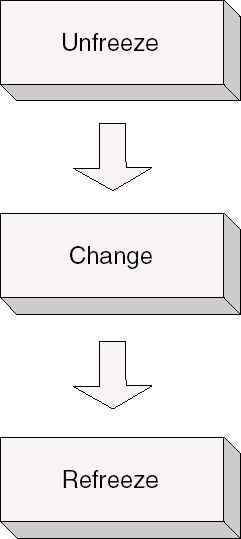8.2. Lewin's Change Theory
One of the simplest and older models of the change process comes from psychologist Kurt Lewin.[] This simple model (Figure 8.2) starts from the assumption that things are in a steady state. Things might be getting better or worse, but they're doing so in a predictable way.
[] Originally from Lewin (1951), this model has been expanded upon elsewhere by Edgar Schein.
Into this steady state we introduce the need to change. The model doesn't explain why we introduce change. The first thing that needs to happen in order to facilitate change is to unfreeze the current status quo. The need for change needs to be explained and people need to be prepared for change. For whatever reason, it needs to be explained that the status quo is no longer an option. Consequently, some unlearning is required: people need to be prepared to give up some existing behaviours and understandings.
Figure 8.2. Lewin's basic change model.

The second step is for the change to take place. At a high level, the model doesn't explain the details of how the change happens. Once the change is complete the model enters the final stage, where the changed system is frozen in the new form.
At a high level, this model serves to outline a simple change process. The need to move from 'what we do now' to an environment in which things are different is clear. Moving from one position to another clearly ...
Get Changing Software Development: Learning to Become Agile now with the O’Reilly learning platform.
O’Reilly members experience books, live events, courses curated by job role, and more from O’Reilly and nearly 200 top publishers.

